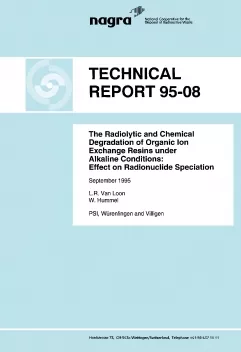
Technical Report NTB 95-08
The Radiolytic and Chemical Degradation of Organic Ion Exchange Resins under Alkaline Conditions: Effect on Radionuclide Speciation
The formation of water soluble organic ligands by the radiolytic and chemical degradation of several ion exchange resins was investigated under conditions close to those of the near field of a cementitious repository. The most important degradation products were characterised and their role on radionuclide speciation evaluated thoroughly.
Irradiation of strong acidic cation exchange resins (Powdex PCH and Lewatite S-100) resulted in the formation of mainly sulphate and dissolved organic carbon. A small part of the carbon (10-20%) could be identified as oxalate. The identity of the remainder is unknown. Complexation studies with Cu2+ and Ni2+ showed the presence of two ligands: oxalate and ligand X. Although ligand X could not be identified, it could be characterised by its concentration ([X]T ~ 10-5 - 10-6 M), a deprotonation constant (pKH ~ 7.4 at I = 0.1 M) and a complexation constant for the NiX complex (logKNiX ~ 7.0 at I = 0.1 M). The influence of oxalate and ligand X on the speciation of radionuclides is examined in detail. For oxalate no significant influence on the speciation of radionuclides is expected. The stronger complexing ligand X may exert some influence depending on its concentration and the values of other parameters. These critical parameters are discussed and limiting values are evaluated.
In the absence of irradiation, no evidence for the formation of ligands was found.
Irradiation of strong basic anion exchange resins (Powdex PAO and Lewatite M-500) resulted in the formation of mainly ammonia, amines and dissolved organic carbon. Up to 50 % of the carbon could be identified as methyl-, dimethyl-and trimethylamine. Complexation studies with Eu3+ showed that the complexing capacity under near field conditions was negligible. The speciation of cations such as Ag, Ni, Cu and Pd can be influenced by the presence of amines. The strongest amine-complexes are formed with Pd and therefore, as an example, the aqueous Pd-ammonia system is examined in great detail.
In the absence of irradiation, no evidence for the formation of ligands was found.
Irradiation of a mixed bed ion exchange resin (Amberlite MB-1) yielded small amounts of sulphate and amines, and a large amount of dissolved organic carbon. Only 3 % of the carbon could be identified as methyl-, dimethyl-and trimethylamine. The major part remained unknown. Complexation studies with Eu3+, however, showed that the complexing capacity under near field conditions was negligible.
In the absence of irradiation, no evidence for the formation of ligands was found.
